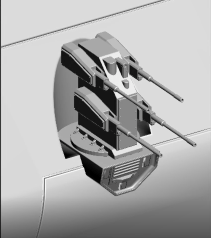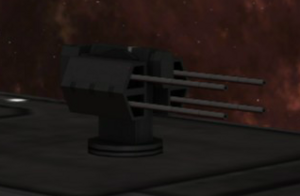Rampart point defense gun
From Halo: Daybreak
The Rampart point defense gun is a line of related close-in weapon systems that are manufactured by Emerson Tactical Systems for the UNSC Navy.
Design[edit | edit source]
Although the Rampart family encompasses weapon systems of all different styles and construction, they all feature the same basic qualities. Their basic construction consists of a quad-linked barrel setup, sitting on the exterior sides of a central core that contains the motors, targeting computer, and ammunition lifts for the cannons. Their primary optics are built into either the forward face or a protrusion on the top of the core, and simultaneously scan through various radio, infrared, light, and ultraviolet spectrums to acquire targets. No Rampart turret has a local ammunition dump built within their exposed structure, with the rounds being selected and stored below the primary armor of a warship. Their skeletal configuration means that, although they can be damaged with sustained fire from space fighters, they are easy to repair and can eject specific major components if they are inoperable or being replaced during maintenance. No Rampart turret has any other secondary systems, such as missiles or countermeasure launchers to confuse attacks. In general, Rampart turrets are simple, easy to maintain, and can maintain a staggering rate of fire, at least when compared to their rivals.
With the exception of the M910 Rampart, all models are classified as medium AA coilguns, which are designed to defeat missiles and hit or suppress fighter attacks. Their rate-of-fire and velocity is considered average for its class, which reflects their intention of being used in a self-defense role. Their range is long enough to screen nearby warships, but a dedicated fire-control system must be fitted to make this possible. Their turret bases allow for unrestricted horizontal travel, greatly expanding their fields of fire. Most Ramparts are armored with cheaper grapheel plating, giving them less protection but cuts down the unit costs.
Variants[edit | edit source]
M800 Rampart[edit | edit source]
No longer manufactured, but remaining in service due to the vast quantities of weapon systems available, the M800 Rampart is a 40mm/70 cal gun battery that innovated the configuration that would be used for all later turrets of the family. It is universally outclassed in all areas by its successors, and it has a firerate of only 1,800 rounds per minute (RPM), while its range is on par with its later, heavier descendants. The UNSC has reclaimed vast numbers of M800s from extensive refitting programs during the Insurrection and the early Human-Covenant War, and they found new life as planetary anti-air emplacements on contested colonies and as active-protection measures on refitted civilian ships such as the Phoenix-class .
M870 Rampart[edit | edit source]
The M870 model of Rampart is easily the most widely adopted model of the design family, well-regarded due to its traits being analogous to a 'middle child' of the Rampart line. Smaller and weaker than later revisions, it is still more dangerous than earlier attempts, and its abundance has seen it being used on everything from corvettes and freighters all the way up to supercarriers.
The M870 Rampart is a squat turret, with two linked batteries each consisting of twin 50mm/50 cal barrels sitting on either side of the rotating core. This configuration ensures that both portions are each capable of traversing a full 180o vertically. Secondary sensor optics in each rotating battery, as well as information fed from the mothership's main computer, means that they can still effectively engage missiles and fighters from behind if necessary. The M870's 50mm rounds are fired at extraordinarily high velocities, enough to screen a battle group flying in close formation. They can also autonomously select from a wide range of ammunition types, from flak to ultra dense rounds to magnetized shells for defeating plasma torpedoes. Each barrel can fire up to 650 rounds per minute, for a total of 2,600RPM. Although they cannot split their fire, as only a single motor controls both the batteries, their skeletal, segmented design means that repairs are a straightforward matter. If a component fails, it can be easily disconnected and replaced at a moment's notice.
M870B Rampart[edit | edit source]

A later hybrid model, the M870B Rampart is an upgraded model that pairs the turret manufactured for the M910 with the guns of the M870, allowing for the barrels to be made longer without compromising on performance. These new 50mm/99 cal guns can fire at faster velocities or have longer barrel life, depending on what settings they are calibrated for.
M910 Rampart[edit | edit source]
First emerging during the Insurrection, when titanium-A1-clad space fighters began to circulate around rogue forces, the M910 Rampart is significant jump in power and capability over its predecessors. It is built on a slim, boxy chassis, with four 105mm/45 cal guns that launch slugs at higher speeds and thus greater ranges. These are typically kinetic penetrator slugs made from tungsten, with a wide variety of other shells - magnetized, fragmentation, and high-velocity guided rounds are all available as standard - being easily loaded by a revamped loading network. Each gun is able to maintain a steady rate of 400RPM, for a total of 1,600RPM across the entire mount. Slightly faster cycling is possible if the M910 selects subcaliber 90mm rounds. Besides the weaponry, many minor upgrades have been added into the new design. The turret's armor is considerably more durable, with a maximum thickness of 70mm, and uses a titanium-alloy hull rather than grapheel used in their predecessors. It can also turn quicker, track opponents through more chaotic environments, and is designed with a targeting system that increases in efficiency with the more point defense guns it controls. Initially, the early turrets had an issue where the lower guns were blocked by the top pair, limiting their vertical elevation. This was later rectified by 2531.
The M910 Rampart represented a split away from other Rampart models, and it was not designed as a replacement for the earlier M870. It was completely specialized for use against enemy fighters, with a limited window in which it could defend against missiles. As a result, many ships mount both models alongside each other, particularly those expected to screen the fleet of all small craft and munitions.


